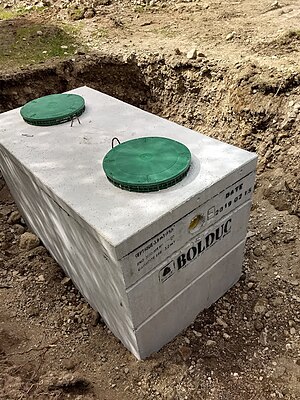
Back خزان صرف صحي Arabic Септична яма Bulgarian Fossa sèptica Catalan Septik Czech Septiktank Danish Klärgrube German Ekskrementa cisterno Esperanto Fosa séptica Spanish Septik Estonian Hobi septiko Basque
| Septic tank | |
|---|---|
 | |
| A septic tank being installed in the ground | |
| Position in sanitation chain | Collection and storage/treatment (on-site)[1] |
| Application level | Household or neighborhood level (schools, hotels etc.)[1] |
| Management level | Household, public, shared (most common is household level)[1] |
| Inputs | blackwater (waste), greywater, brownwater[1] |
| Outputs | Fecal sludge, effluent[1] |
| Types | Single tank or multi-chamber septic tanks (potentially with baffles)[1] |
| Environmental concerns | Groundwater pollution, water pollution e.g. during floods[1] |
A septic tank is an underground chamber made of concrete, fiberglass, or plastic through which domestic wastewater (sewage) flows for basic sewage treatment.[2] Settling and anaerobic digestion processes reduce solids and organics, but the treatment efficiency is only moderate (referred to as "primary treatment").[2] Septic tank systems are a type of simple onsite sewage facility. They can be used in areas that are not connected to a sewerage system, such as rural areas. The treated liquid effluent is commonly disposed in a septic drain field, which provides further treatment. Nonetheless, groundwater pollution may occur and is a problem.
The term "septic" refers to the anaerobic bacterial environment that develops in the tank that decomposes or mineralizes the waste discharged into the tank. Septic tanks can be coupled with other onsite wastewater treatment units such as biofilters or aerobic systems involving artificially forced aeration.[3]
The rate of accumulation of sludge—also called septage or fecal sludge—is faster than the rate of decomposition.[2] Therefore, the accumulated fecal sludge must be periodically removed, which is commonly done with a vacuum truck.[4]
- ^ a b c d e f g "Sanitation Systems – Sanitation Technologies – Septic Tank". SSWM. 19 June 2018. Retrieved 31 October 2018.
- ^ a b c Tilley, Elizabeth; Ulrich, Lukas; Lüthi, Christoph; Reymond, Philippe; Zurbrügg, Chris (2014). "Septic tanks". Compendium of Sanitation Systems and Technologies (2nd ed.). Duebendorf, Switzerland: Swiss Federal Institute of Aquatic Science and Technology (Eawag). ISBN 978-3906484570.
- ^ "Septic Systems for Waste Water Disposal". American Ground Water Trust. Archived from the original on 2008-05-17. Retrieved 2008-05-20.
- ^ "What is a septic system? How do I maintain one?". National Environmental Services Center. nesc. Archived from the original on 26 April 2016. Retrieved 4 March 2015.
© MMXXIII Rich X Search. We shall prevail. All rights reserved. Rich X Search